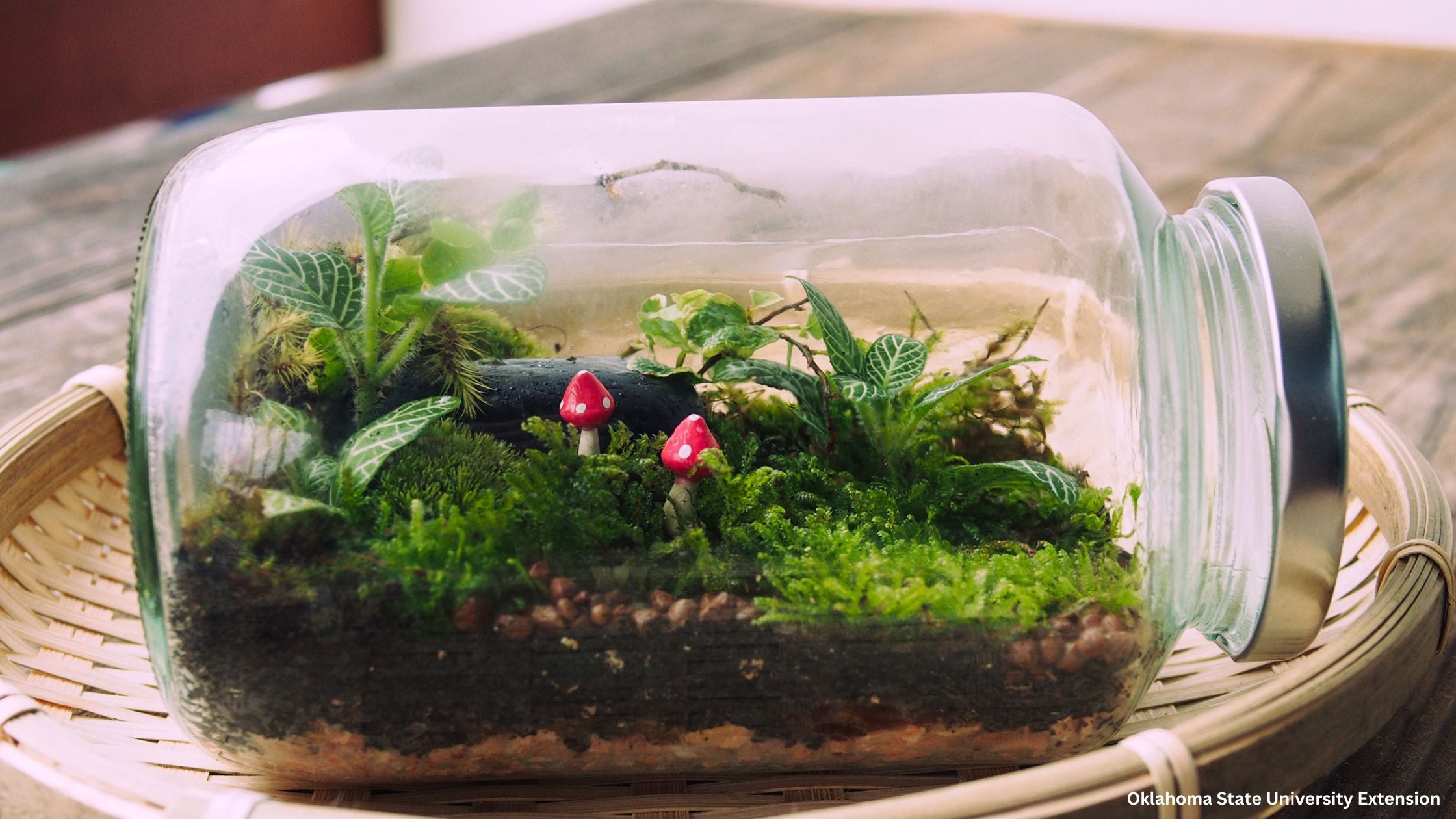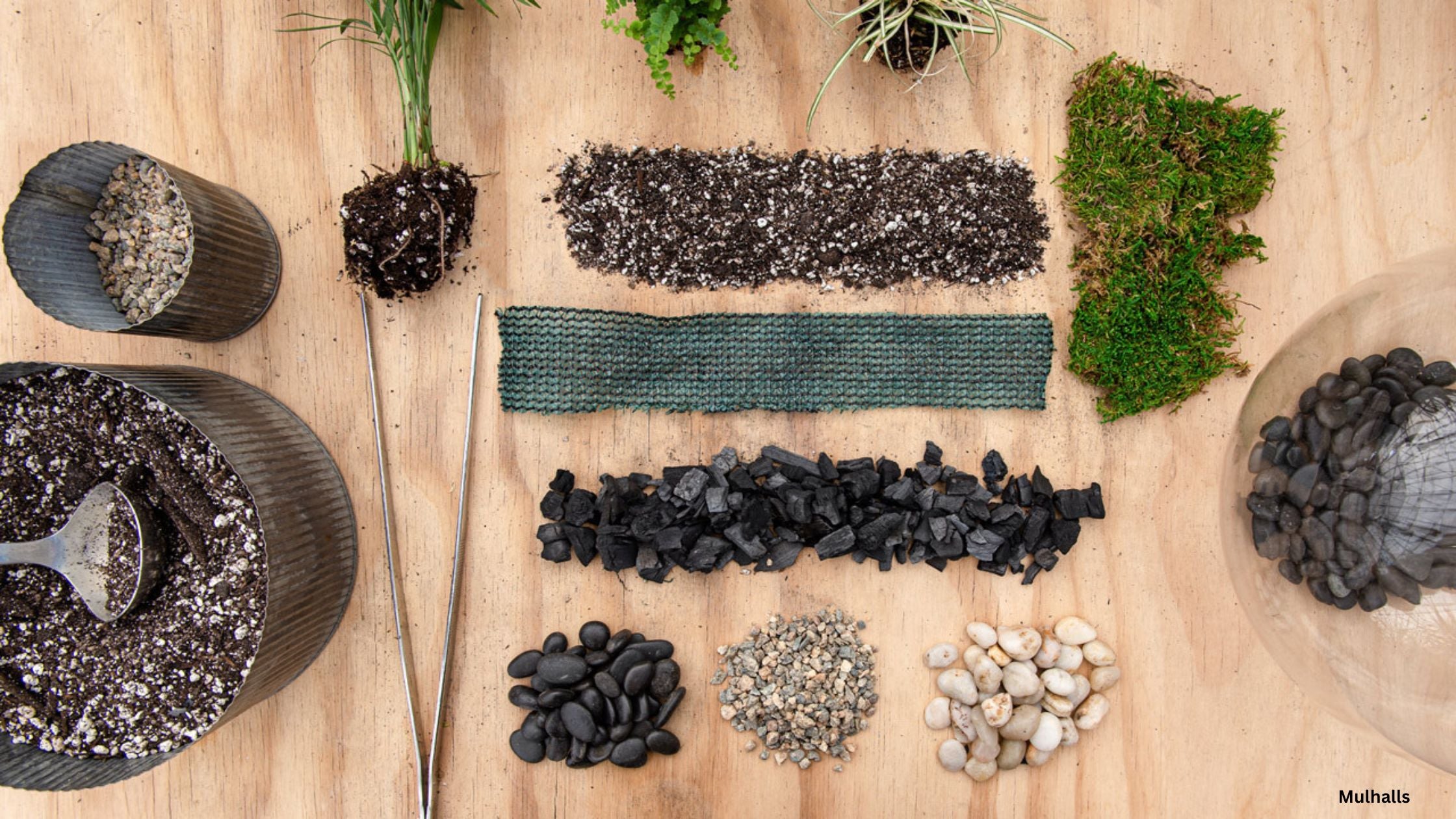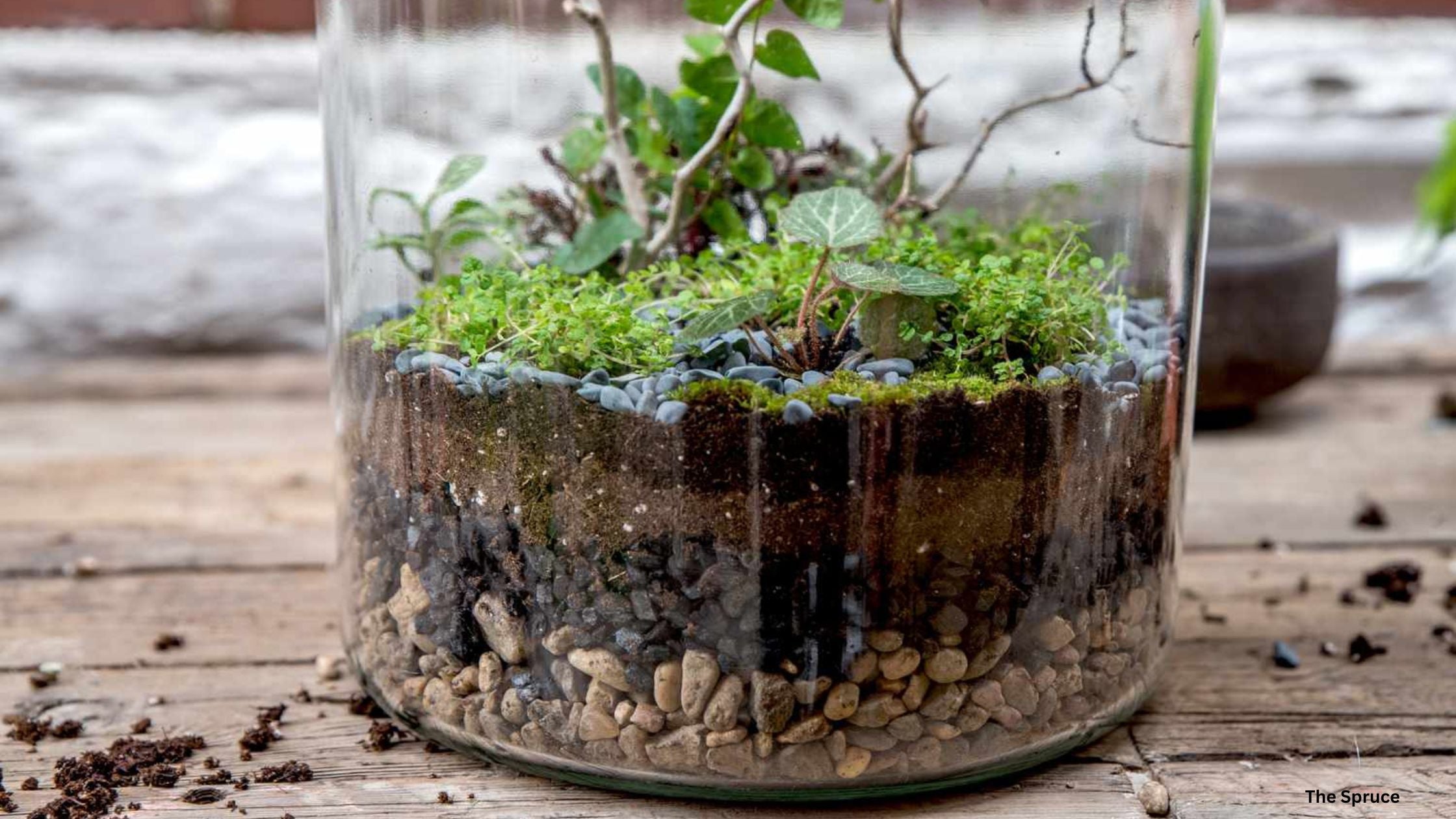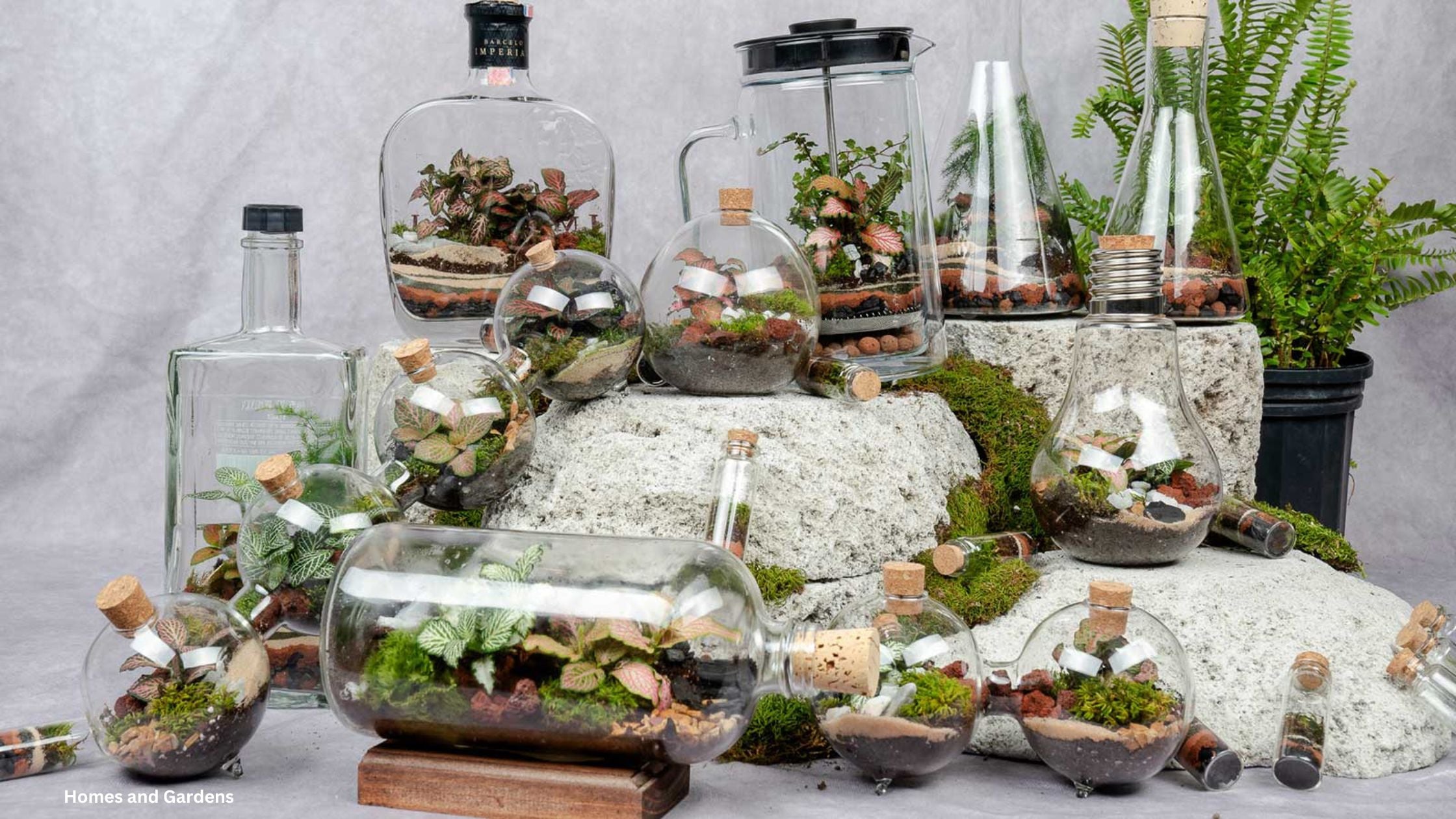Create Your Own Glass Terrarium – The Basics

Setting up a terrarium is a fun creative project for plant lovers and miniature indoor garden enthusiasts. It brings in a touch of nature without taking up a lot of space in your home. Closed terrariums can be elaborate metal ‘greenhouses’ with glass walls and a waterproof base or a simple glass jar you have handy at home. If you are a beginner, I recommend medium to large glass terrariums with lids. A lid insures adequate humidity for some hard to grow tropical plants in our dry environment. Other advantages include: Less maintenance than an open terrarium, the planting space is easier to work with, the plants will take longer to outgrow their space and you will have a front row seat to see all the changes that occur over time.
This article covers terrarium building for plants only. If you are planning a reptile enclosure, please consult your local pet store for your pet’s specific needs.
Before you begin your project take some time to read about rainforests and the growing conditions in those areas of the world. You are going to be building a mini rain forest!
Collect Your Supplies
Gather all your supplies before starting to build your terrarium.

You will need:
Gloves, a pair of long nosed tweezers – the longer the better, scissors, a small watering can filled with water, leca (lightweight and durable) and a small bag of activated charcoal. Your soil mix (see below for recipe), plants and decorative accessories such as mini figurines, driftwood and rock. Sphagnum moss, sheet moss or cushion moss and window screening.
Cover your work area with a plastic tablecloth or very large garbage bag. This can get messy!
Clean your terrarium with a 2 cup hot water and ½ cup vinegar solution to sterilize the interior. Dry thoroughly and set aside.
Mix the soil. There are many terrarium soil recipes and most use the same basic ingredients and are very good. Good drainage is key to a successful terrarium.
1 part tropical plant soil
1 part dampened cocoa fibre
1 part fine orchid bark
½ part activated charcoal
½ part horticultural sand
A handful or two of worm castings.
Mix well and add just enough water to dampen it, then mix again.
I like to use activated charcoal because it filters and removes toxins/bacteria from the soil and water. It also helps to prevent odors. Do not use charcoal that is used for grilling. It contains petroleum.

Decorative Accessories: Over the past few years there has been a resurgence of interest in creating fairy gardens. This makes miniature garden accessories readily available for just about any project, including setting up a closed terrarium. Other accessories include larger rock such as black or red lava rock, pieces of driftwood, slate, stone, cork bark and aquarium accent pieces.
Mold can be a problem when you overwater. If you have a reoccurring mold problem, add a few springtails to your terrarium. They are a deterrent and a solution. Springtails are tiny insects that love to eat mold. They will not eat your plants. If this makes you a bit squeamish, you can also air out the container periodically and remove any moldy driftwood or accessories. Use a cotton swab and dab the mold with full strength 3 % hydrogen peroxide. Activated charcoal also keeps mold and mildew at bay but is not a full proof remedy.
Plants
The following is a list of tropical plants that do very well in a closed terrarium. The plants you choose should like the same growing conditions. Most on the list like a bright room but do not put your terrarium in full sun. This will heat up the interior and kill the plants. It is important to start with a few small slow growing plants, (2 inch pot diameter), or rooted cuttings so you can enjoy watching them grow. Do not be afraid to prune them back at any time.
Nerve Plant – Fittonia
Jewel Orchids
Friendship Plant (Pilea involucrata) and Silver Sparkle Pilea (PIlea glauca)
Frosty Fern Spike Moss (Selaginella kraussiana ‘Variegated’)
Venus Fly Traps - Open the terrarium occasionally to feed. They will eat spring tails or you can feed them ants, flies and tiny spiders. Only use distilled water or rainwater when watering.
Creeping Fig – green and variegated. Root branch cuttings in water.
Crocodile Fern
Cryptanthus – also known as Earth Stars. They grow in the rainforests of Brazil!
Maidenhair Ferns
Polka Dot Plant – pink, red and silver. They require bright, indirect light.
Prayer Plants – for larger closed terrariums.
Pothos – for larger closed terrariums. Prune regularly – low light.
Baby Tears – This is the Baby Tears with very tiny leaves forming a low mat in the pot. – (Soleirolia soleirolii)
English ivy varieties – Start with small rooted cuttings. Green and variegated cultivars.
Watermelon Begonia – (Pellionaria repens)
Artillery Fern – (Pilea microphylla)

Setting Up Your Terrarium
Add a 2.5 cm depth of leca to the bottom of your container. Leca will absorb any drained water, making it available for the plants in the future. An established terrarium will rarely need watering.
Insert the screen so it covers the leca and goes up the sides of the terrarium just a bit. This will ensure the soil does not go into drainage area.
Top the screen with a 1.25 cm depth of activated charcoal.
Add your soil mix at double the depth of the false bottom. You can add more if you feel it’s necessary.
(Some people slope the soil up at the back of the terrarium. This is dependent on the viewing angle. It’s all up to you!)
Place any large accessories. You may want to try your design outside the terrarium first. Do not be afraid to try different designs.
Place the plants. Do not overcrowd. Remember, less is more. They will grow! Use your long tweezers to help place small rooted cuttings. They also come in handy to place tiny pieces of moss.
Water lightly and close the lid. Water every two to three weeks until established. Do Not Overwater! Regularly open the terrarium after establishment once every two weeks. The most important thing to remember is to water lightly; just enough to keep the soil layer slightly damp – never soggy. The water will cycle in your closed terrarium through condensation.
Add any remaining accessories and close with the lid.
Place your terrarium in a bright to medium bright room.
You can also provide adequate light conditions for your terrarium by buying a single stand LED grow light and timer. Twelve hours on; twelve hours off is recommended.
Things You Might Like to Know
If you do not have a lid for a favorite terrarium, take a measurement of the top opening and purchase a round piece of acrylic just large enough in diameter to fit or go over the opening of the container. If you choose, drill a couple of small holes in the acrylic lid. This will slightly aerate the container and not affect the water cycle.
